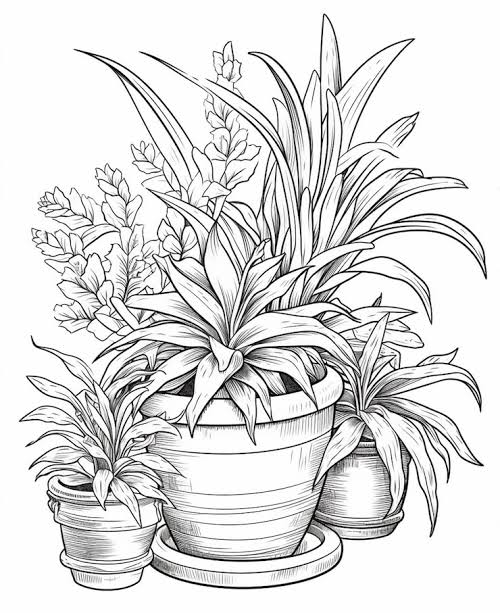Drawing plants is one of the most enjoyable and rewarding activities for artists, hobbyists, and even children. Whether you’re sketching a simple leaf, a blooming flower, or a full potted plant, learning the process step by step can spark creativity and improve your drawing skills. If you’ve ever wondered, “How do I start? Where do I put the first line?”—you’re in the right place.In this article, we’ll walk you through the unbelievable how to draw a plant step by step! process, offering easy instructions, helpful techniques, and expert tips. By the end, you’ll be confident enough to create your own green masterpieces, whether for fun, art practice, or even decorating homemade cards.Why Learn to Draw Plants?Before diving into the step-by-step guide, let’s explore why plants are such popular subjects for drawing:Versatility: Plants come in endless shapes and forms, from succulents to sunflowers.Beginner-friendly: Their natural irregularities make mistakes less noticeable.Relaxing: Sketching plants can feel meditative and soothing.Practical: Botanical illustrations are useful for school projects, journals, or even professional art portfolios.No matter your age or skill level, you’ll find it exciting to discover the unbelievable how to draw a plant step by step! technique.Getting Started: What You’ll NeedBefore you start drawing, gather the right tools:Pencils (HB for outlines, 2B or 4B for shading)Eraser (kneaded or soft for subtle corrections)Sharpener (to keep lines crisp)Paper (sketchpad or printer paper works fine)Optional: Colored pencils, watercolors, or markers to add vibrancyHaving your materials ready ensures a smooth and stress-free experience.Step-by-Step Guide: Unbelievable How to Draw a Plant Step by Step!Now, let’s break down the drawing process in clear, manageable steps.Step 1: Outline the Pot or BaseStart by lightly sketching the plant’s container—often a pot. Use simple geometric shapes like a rectangle, oval, or trapezoid. Keep your lines soft, as you may refine them later.Step 2: Draw the StemFrom the center of the pot, sketch a vertical line upward. This will be your plant’s main stem. Add a little curve to make it look natural rather than stiff.Step 3: Add Branches or OffshootsExtend smaller lines from the main stem. These represent branches or smaller stems that will hold leaves or flowers.Step 4: Sketch the LeavesPlants are defined by their leaves. To create believable leaves:Use teardrop or oval shapes.Vary the sizes—real leaves aren’t identical.Position them along the stem in alternating patterns for realism.Step 5: Add Flowers or Details (Optional)If your plant is flowering, add simple petal shapes. You can start with circles as guides and then draw petals radiating outward.Step 6: Refine the OutlineDarken the main lines you want to keep, and erase any unnecessary sketch marks.Step 7: Add Texture and ShadingShade the underside of leaves for depth.Use cross-hatching or smooth shading to make the pot look three-dimensional.Add veins to the leaves using light, fine lines.Step 8: Add Color (Optional)Finish with color if you’d like:Greens for the leaves.Browns or terracotta for the pot.Bright hues for flowers.That’s it—you’ve just learned the unbelievable how to draw a plant step by step!Practical Tips for Plant Drawing SuccessEven though the process seems straightforward, a few insider tips can take your sketches from good to great.Observe Real PlantsKeep a small houseplant nearby as a live model. Notice how leaves overlap, bend, or twist—details that photos may not always show.Practice Leaf ShapesLeaves come in many shapes: round, heart-shaped, narrow, or lobed. Practicing different leaf patterns expands your drawing vocabulary.Start Simple, Then Add ComplexityIf you’re new, begin with a cactus or succulent, which have straightforward shapes. Later, move on to ferns or flowering plants for more detail.Play with PerspectiveTry drawing your plant from above, from the side, or at an angle. This adds variety and challenges your eye-hand coordination.Use Light and ShadowShading is what makes your plant pop off the page. Imagine where the light is coming from, then darken the opposite areas.Common Mistakes and How to Avoid ThemOver-symmetry: Real plants aren’t perfect mirrors—vary your leaves slightly.Heavy Outlines: Dark lines everywhere can make your plant look flat. Use softer strokes for subtle areas.Ignoring Scale: Oversized leaves on a tiny pot can look unrealistic—keep proportions in mind.Skipping Shading: Without light and shadow, your plant will appear flat and lifeless.By avoiding these pitfalls, your unbelievable how to draw a plant step by step! journey will be much smoother.Advanced Ideas for Creative Plant DrawingsOnce you’ve mastered the basics, try these fun variations:Botanical Illustration: Add scientific labels for an educational look.Cartoon Plants: Exaggerate leaf shapes or add cute faces.Pattern Art: Turn your plant sketches into repeating patterns for wallpapers or fabric designs.Mixed Media: Combine pencil sketches with watercolor splashes for a vibrant effect.These techniques keep your drawings fresh and exciting.Why This Skill Is More Valuable Than You ThinkBeing able to draw plants isn’t just about art—it connects you to nature, improves observation skills, and even boosts mindfulness. Many people in the United States, United Kingdom, and Canada use plant drawing as a calming hobby, while others turn it into a side business by creating botanical prints or greeting cards.When you embrace the unbelievable how to draw a plant step by step! method, you’re not only learning a skill—you’re gaining a lifelong creative outlet.ConclusionPlants have captivated artists for centuries, and now it’s your turn to bring them to life on paper. From sketching simple outlines to adding realistic shading and colors, the process is both relaxing and fulfilling. With patience and practice, anyone can master the unbelievable how to draw a plant step by step! technique.So grab your pencil, find a cozy spot, and let nature inspire your next masterpiece. Remember—every great artist started with a single line.

